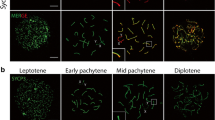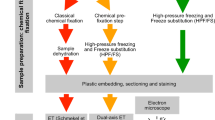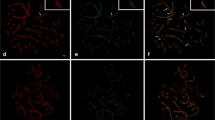Abstract
Synaptonemal complex (SC) studies in male mice from the beginning of meiosis to its completion (7–40 days of age) indicate: (1) the existence of a leptotene stage with fragmented and completely unpaired axial elements; (2) that synapsis begins at several different initiation points of the axial elements, resulting in X-shaped and Y-shaped configurations; (3) that interlocking of axial elements at zygotene is a normal phenomenon; and (4) that zygotene (presynaptic) and diplotene (postsynaptic) configurations are different from each other.
Similar content being viewed by others
References
Bojko, M., 1983. Human meiosis VIII. Chromosome pairing and formation of the synaptonemal in oocytes. Carlsberg Res. Commun. 48: 457–483.
Capanna, E., 1980. Presence and role of contractile proteins in the vertebrate synaptonemal complex. Boll. Zool. 47: 231–235.
Counce, S. L. & Meyer, G. F., 1973. Differentiation of the synaptonemal complex and the kinetochore in Locusta spermatocytes studied by whole mount electron microscopy. Chromosoma 44: 231–253.
Dietrich, A. J. J. & Mulder, R. J. P., 1981. A light microscopy study of the development and behaviour of the synaptonemal complex in spermatocyte of the mouse. Chromosoma 83: 409–418.
Dietrich, A. J. J. & Mulder, R. J. P., 1983. A light and electron microscopic analysis of meiotic prophase in female mice. Chromosoma 88: 377–385.
Dietrich, A. J. J. & De Boer, P., 1983. A sequential analysis of the development of the synaptonemal complex in spermatocytes of the mouse by electron microscopy using hydroxyurea and agar filtration. Genetica 61: 119–129.
Dresser, M. E. & Moses, M. J., 1980. Synaptonemal complex karyotyping in spermatocytes of the Chinese hamster (Cricetulus griseus). IV. Light and electron microscopy of synapsis and nucleolar development by silver stining. Chromosoma 76: 1–22.
Esponda, P. & Stocker, J. C., 1971. Localization of RNA in the synaptonemal complex. J. Ultrastruct. Res. 35: 411–417.
Felluga, B. & Martinucci, G. B., 1976. A simple method for karyotyping by transmission electron microscopy. J. submicrosc. Cytol. 8: 347–352.
Fletcher, M. L., 1977. Localised chiasmata Due to Partial Pairing: A 3D Reconstruction of Synaptonemal Complexes in Male Stethophyma grossum. Chromosoma 65: 247–269.
Fletcher, M. L., 1979. Light microscope analysis of meiotic prophase chromosomes by silver staining. Chromosoma 72: 241–248.
Grell, R. F., Oakberg, E. P. & Generoso, E. E., 1980. Synaptonemal complexes at premeiotic interphase in the mouse spermatocyte. Proc. natn. Acad. Sci. USA, 77, 11: 6720–6723.
Hartung, M., Keeling, J. W., Patel, C. & Bobrow, M., 1983. Nucleoli, micronucleoli and nucleolus like structures in human oocytes at meiotic prophase I studied by the silver-NOR technique. Cytogenet. Cell Genet. 35: 2–8.
Hofgärtner, F. J., Schmid, M., Krone, W., Zenzes, M. T. & Engel, W., 1979. Pattern of activity of nucleolus organizers during spermatogenesis in mammals as analyzed by silver staining. Chromosoma 71: 197–216.
Holm, P. B., Rasmussen, S. W. & Wettstein, D., 1982. Ultrastructural characterization of the meiotic prophase. A tool in the assessment of radiation damage in man. Int. Res. 95: 45–49.
Kierszenbaum, A. I. & Tres, L. L., 1974. Transcription sites in spread meiotic prophase chromosomes of mouse spermatocytes. J. Cell Biol. 63: 923–925.
Knibiehler, B., Mirre, C., Hartung, M., Jean, P., Stahl, A., 1981. Sex vesicle-associated nucleolar organizers in mouse spermatocytes. Localization, structure and function. Cytogenet. Cell Genet. 31: 47–57.
Moens, P. B., 1973. Quantitative electron microscopy of chromosome organization at meiotic prophase. Cold Spring Harb. Symp. quant. Biol. 38: 99–107.
Moses, M. J., 1977a. Synaptonemal complex karyotyping in spermatocytes of the Chinese hamster (Cricetulus griseus) I. Morphology of the autosomal complement in spread preparations. Chromosoma 69: 99–125.
Moses, M. J., 1977b. Synaptonemal complex karyotyping in spermatocytes of the Chinese hamster (Cricetulus griseus). II. Morphology of the XY pair in spread preparations. Chromosoma 60: 127–137.
Moses, M. J., 1980. In: Anima models in human reproduction (M. Serio, ed.). Raven, New York, pp. 169–190.
Navarro, J., Vidal, F., Guitart, M. & Egozcue, J., 1981. A method for sequential study of synaptonemal complexes by light and electron microscopy. Hum. Genet. 59: 419–421.
Oud, J. L., De Jong, J. H. & De Rooij, D. G., 1979. A sequential analysis of meiosis in the male mouse using a restricted spermatocyte population obtained by a hydroxyurea/triaziquone treatment. Chromosoma 71: 237–248.
Oud, J. L. & Reutlinger, A. H. H., 1981. Chromosome behaviour during early meiotic prophase of mouse primary spermatocytes. Chromosoma 83: 395–407.
Pathak, S. & Hsu, T. C., 1979. Silver-stained structures in mammalian meiotic prophase. Chromosoma 70: 195–203.
Schmid, M., Löser, C., Schmidtke, J. & Engel, W., 1982. Evolutionary conservation of a common pattern of activity of nucleolus organizers during spermatogenesis in vertebrate. Chromosoma 86: 149–179.
Sheridan, W. & Barnett, R. J., 1969. Cytochemical studies on chromosome ultrastructure. J. Ultrastruct. Res. 27: 216–229.
Solari, A. J. & Counce, S. J., 1977. Synaptonemal complex karyotyping in Melanoplus differentialis. J. Cell Sci. 26: 229–250.
Speed, R. M., 1982. Meiosis in the foetal mouse ovary. I. An analysis at the light microscope level using surface spreading. Chromosoma 85: 427–437.
Tres, L. L., 1977. Extensive pairing of the XY bivalent in mouse spermatocytes as visualized by whole-mount electron microscopy. J. Cell Sci. 25: 1–15.
Vidal, F., Templado, C., Navarro, J., Brusadin, S., Marina, S. & Egozcue, J., 1982. Meiotic and synaptonemal complex stuties in 45 subfertile males. Hum. Genet. 60: 301–304.
Wettstein, R. & Sotelo, J. R., 1967. Electron microscope serial reconstruction of the spermatocytes I nuclei at pachytene. J. Microsc. 6: 557–576.
Author information
Authors and Affiliations
Additional information
This investigation received financial support from the special Programme of Research, Development and Research Training in Human Reproduction, World Health Organization.
Rights and permissions
About this article
Cite this article
Guitart, M., Coll, M.D., Ponsà, M. et al. Sequential study of synaptonemal complexes in mouse spermatocytes by light and electron microscopy. Genetica 67, 21–30 (1985). https://doi.org/10.1007/BF02424457
Received:
Accepted:
Issue Date:
DOI: https://doi.org/10.1007/BF02424457




